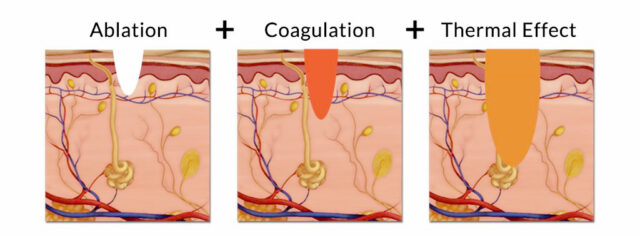Coagulation Effect of Fractional Non-Ablative Laser
Fractional non-ablative laser therapy has revolutionized the field of skin treatment by focusing on coagulation, a process that significantly contributes to skin tightening and rejuvenation. Unlike ablative treatments that remove layers of skin, non-ablative lasers work beneath the skin’s surface, employing coagulation to promote healing and transformation.
Understanding Coagulation
Coagulation is the process by which blood changes from a liquid to a gel, forming a clot. In the context of fractional non-ablative laser therapy, such as Fraxel, coagulation refers to collagen cocking and to the controlled damage of specific skin tissues, creating a natural response that leads to healing and regeneration.
How Does Coagulation Work in Fractional Non-Ablative Laser Therapy?
- Targeted Coagulation: The laser beams create microthermal zones, coagulating small fractions of tissue. This targeted approach leaves the surrounding tissue intact, focusing the healing response where it’s most needed.
- Initiating the Healing Response: The coagulated tissue signals the body to initiate its natural healing processes. This includes the removal of damaged tissue and the stimulation of collagen production.
- Collagen Synthesis: Collagen is crucial to the skin’s structure and elasticity. The coagulation effect of the laser stimulates collagen synthesis, leading to firmer, more youthful skin.
- Reduced Scarring and Hyperpigmentation: By focusing on coagulation rather than vaporization, fractional non-ablative lasers minimize potential scarring and discoloration, providing a more uniform complexion.
Benefits of Coagulation-Based Treatment
- Controlled Treatment: By targeting only specific areas, the therapy minimizes damage to surrounding tissues, reducing recovery time.
- Enhanced Skin Appearance: The coagulation process tightens and smoothes the skin, reducing wrinkles and improving texture.
- Adaptability: The treatment can be adjusted to various skin types and problems, providing a versatile solution to skin rejuvenation needs.
- Non-Invasive: The non-ablative approach ensures minimal discomfort and downtime, making it more appealing to patients seeking non-invasive options.
The coagulation effect of fractional non-ablative laser therapy is central to its effectiveness in skin rejuvenation. By creating controlled coagulation zones within the skin, the therapy encourages natural healing and collagen production, resulting in a more youthful and vibrant appearance. This precise approach, focusing on the coagulation rather than the destruction of the skin, makes it an innovative and highly sought-after treatment for various skin concerns, with minimal risk and recovery time. Its role in promoting skin health and beauty continues to affirm its place as a leading method in modern dermatological practice.


